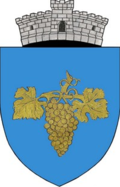Jidvei
|
Jidvei silk Zsidve |
||||
|
||||
| Basic data | ||||
|---|---|---|---|---|
| State : |
|
|||
| Historical region : | Transylvania | |||
| Circle : | Alba | |||
| Coordinates : | 46 ° 14 ' N , 24 ° 7' E | |||
| Time zone : | EET ( UTC +2) | |||
| Height : | 271 m | |||
| Area : | 105.12 km² | |||
| Residents : | 4,617 (October 20, 2011) | |||
| Population density : | 44 inhabitants per km² | |||
| Postal code : | 517385 | |||
| Telephone code : | (+40) 02 58 | |||
| License plate : | FROM | |||
| Structure and administration (as of 2016) | ||||
| Community type : | local community | |||
| Structure : | Jidvei, Bălcaciu , Căpâlna de Jos , Feisa , Veseuș | |||
| Mayor : | Alin Trif ( PNL ) | |||
| Postal address : | Str. Perilor No. 15 loc. Jidvei, jud. Alba, RO-517385 |
|||
| Website : | ||||
Jidvei (outdated Jidveiu; German Seiden or Sögden , Hungarian Zsidve ) is a Romanian municipality in the Alba district in Transylvania .
Geographical location
Jidvei is located in the east of the Alba district, in the west of the Transylvanian Basin in a left side valley on the lower reaches of the Târnava Mică (Little Kokel) on the Blaj – Praid railway line . The place is on the county road (Drum județean) DJ 107, each about 20 kilometers northeast of Blaj (Blasendorf) and southwest of Târnăveni (Sankt Martin) Mureș district ; the district capital Alba Iulia is about 55 kilometers southwest of Jidvei.
history
Various archaeological finds (starting from the Neolithic Age ) show that the area of the municipality was inhabited for a long time.
Jidvei is a place founded by the Transylvanian Saxons . It was mentioned in a document for the first time in 1309 on the occasion of a tithing dispute - which was led by (Transylvanian) -Saxon deaneries against the Weißenburg cathedral chapter. Administratively, the village was divided into two parts, the eastern part of the village was on county soil , the western part was inhabited by free Saxons . Documents on silk prove that in 1453 King Ladislaus V, on the suggestion of voivod J. Hunyadi , granted the community blood jurisdiction in gratitude for the bravery shown in the battle against the Turks on the Blackbird Field. 76 tax-paying Saxon families are registered in the register of the Protestant parish, which was created in 1699; In 1786 1084 German citizens were counted.
The main occupation of the population was agriculture, viticulture and cattle breeding. Because of the large state winery , the place is known far beyond the national borders as a winegrowing village (see: Viticulture in Romania ).
population
The population of the municipality developed as follows:
| census | Ethnic composition | |||||||
|---|---|---|---|---|---|---|---|---|
| year | population | Romanians | Hungary | German | other | |||
| 1850 | 4,696 | 1,886 | 84 | 2,281 | 445 | |||
| 1900 | 5,439 | 2,503 | 278 | 2,454 | 204 | |||
| 1941 | 6,800 | 3,372 | 153 | 2,743 | 532 | |||
| 1977 | 6,720 | 4,419 | 191 | 1,696 | 414 | |||
| 1992 | 5,354 | 3,976 | 173 | 205 | 1,000 | |||
| 2002 | 5,244 | 4,245 | 145 | 96 | 785 | |||
| 2011 | 4,617 | 3,237 | 96 | 55 | 1,229 | |||
The highest number of inhabitants (7028) of today's municipality was determined in 1966; that of the Romanians (4899) in 2002, the Germans in 1941, the Hungarians in 1900 and that of the Roma (1071) in 2011. Furthermore, one Slovak was registered in 1930 and 1977, and two Ukrainians in 2011 .
Of about 129 soldiers who participated in the war, 20 men died in the First World War ; in the Second World War from about 194 men 50 Saxons on different fronts. In 1945, 236 Saxon women and men were deported to the Soviet Union for forced labor , of which 26 were killed.
Attractions
- The fortified church, built around 1500. The walls were removed in the 19th century, the gate tower has been preserved. The church's former Gothic altar was replaced by a Baroque altar in 1795; In 1797 a new hall was built. The church and the remains of the fortified church are under monument protection.
- The Romanian Orthodox Church Sf. Nicolae, completed in 2002.
- The Romanian Greek Catholic Holy Trinity Church , built in 1996.
Personalities
- Hans Barth (* 1934 in Jidvei; † 2011 in Aschaffenburg), publicist and science author
literature
- Fredrick H. Barth: Bread with Bacon and Onion. A Transylvanian life story. Degener Verlag, 1980. ISBN 3-7686-4088-4 .
- Since 1987, once a year, 350 copies (information from and about Seiden), Det Weimerblat ("The grape leaf ") have been published.
Web links
Individual evidence
- ↑ 2011 census in Romania ( MS Excel ; 1.3 MB)
- ↑ Mayoral elections 2016 in Romania ( MS Excel ; 256 kB)
- ^ Dictionary of the localities in Transylvania
- ^ Institute Of Archeology - Jidvei, accessed February 23, 2010 (Romanian)
- ↑ a b c History of silk on Siebenbuerger.de Places
- ↑ a b Heinz Heltmann, Gustav Servatius (Ed.): Travel Guide Siebenbürgen. Kraft-Verlag, Würzburg 1993, ISBN 3-8083-2019-2 .
- ↑ Census, last updated October 30, 2008, p. 101 (Hungarian; PDF; 1.2 MB)
- ↑ List of historical monuments of the Romanian Ministry of Culture, updated 2010 (PDF; 7.10 MB)



